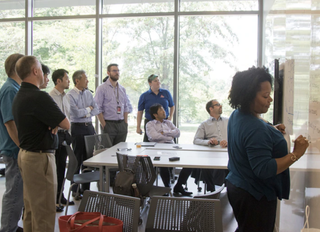With the support of 11 U.S. colleges and universities, Sony Electronics has developed the Future Learning Collaborative, an initiative designed to foster open and candid dialogue among higher education institutions about the role of technology in supporting teaching and learning.
Collaborative members are comprised of faculty and administration leaders from a broad range of schools throughout the country who are working together with Sony designers and researchers to develop new classroom technologies and enable more effective teaching methods—with the ultimate goal of creating a deeper and more immersive learning experience for students.
“Our top priority is improving every aspect of instruction, which necessitates exploring the most effective uses of technology in the classroom,” said Edward Gomes, senior associate dean at Duke University and a charter member of the Collaborative. “By working closely with Sony and our colleagues, we’ve created an environment that addresses our common frustrations, encourages honest feedback about the development of classroom technologies, and enables educators and administrators to come together and share best practices that will shape the future of higher education.”
The Collaborative—a cross-section of public, private, two- and four-year institutions—has met regularly since November 2017 for working sessions, focus groups, and technology demonstrations facilitated by Entangled Studios. In each meeting, members shared ideas, asked questions, and participated in candid discussions about teaching and learning technologies and pedagogical strategies. In the coming months, the Collaborative will begin regularly sharing its findings with the broader higher education community.
“Transforming innovative ideas into meaningful institutional change can be a complex, time-intensive process—one that often takes a back seat to the day-to-day issues on campus,” said Stacy Morrone, associate vice president for learning technologies at Indiana University. “Building on our long-standing partnership with Sony, the work of the Collaborative not only helps us keep focus on the bigger picture—it also enables us to learn from the successes and pain points of institutions across the country.”

Sony says this initiative is the result of its decades-long commitment to providing creative products and solutions that directly support the mission and vision of higher education institutions. The company’s work with colleges and universities ranges from manufacturing products for classrooms and presentations to developing virtual and augmented reality activations for admissions to leading the design and system integration of new campus facilities.
“At a publicly funded urban university like ours, it’s critical to ensure that technology solutions and pedagogical strategies are not only affordable, but also serve the diverse needs of our student body,” said Dr. Brian Beatty, associate vice president for academic affairs operations at San Francisco State University. “Sony and our peers in the Collaborative have been invaluable thought partners as we engage faculty, staff, and students alike in designing and implementing tools that promote engaged and active learning.”
Members of the Collaborative include: American University, Arizona State University, Dartmouth College, Duke University, Houston Community College, Indiana University, Montclair State University, Northwestern University, San Francisco State University, University of California San Diego, and University of Central Florida.
“The work of the Collaborative is rooted in Sony’s fundamental philosophy of designing with purpose and developing technology that reflects the experiences—and concerns—of practitioners across a range of fields,” said Satoshi Kanemura, head of B2B of America, Sony Electronics. “Higher education’s mission and complexity present a unique opportunity for our team. Having the support of institutions through their investment of time, and their willingness to share perspectives, enables us to develop solutions that are both actionable and relevant to meet our mutual goal of student success.”









